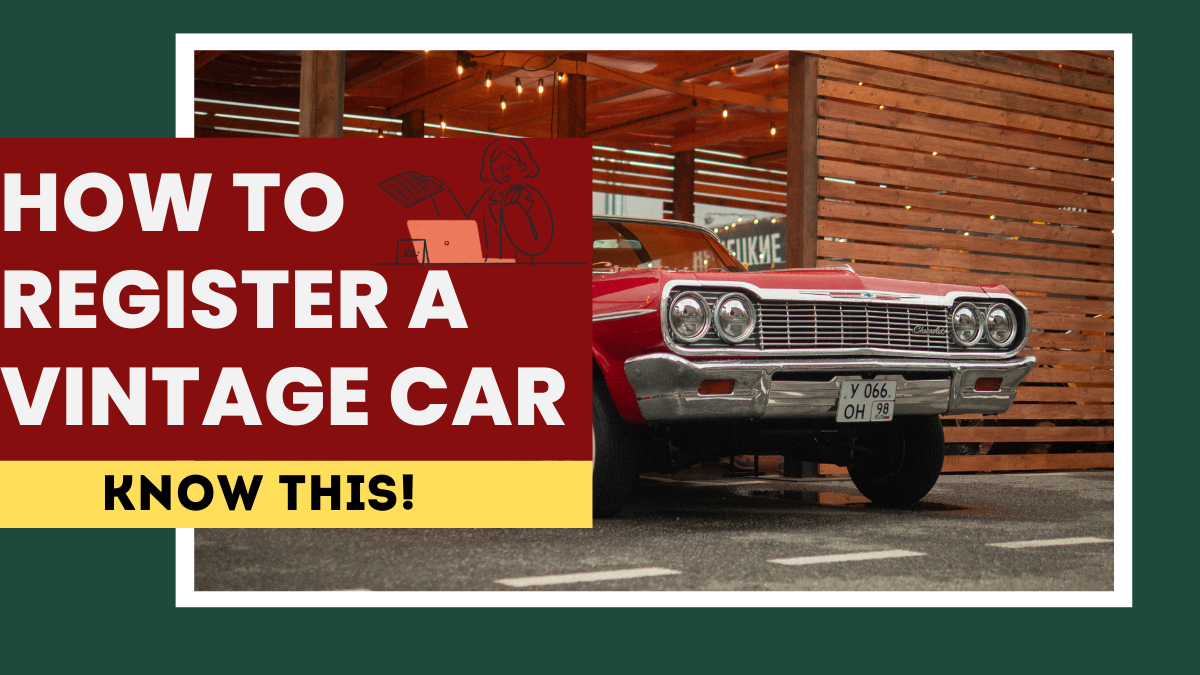Buying or inheriting a vintage car is an exciting milestone, but before you can proudly drive it on public roads or show it at official events, you need to ensure it is legally registered. The process of how to register a vintage car legally differs from modern car registration because these vehicles are often decades old, may lack standard paperwork, and require special permits. This classic car registration guide explains the steps, documents, and rules you need to know so your prized possession is recognized as a roadworthy and lawful vehicle.

Why Registration Is Important
Registering a vintage car is not just a legal requirement; it also provides proof of ownership and authenticity. Without proper registration, you may face issues during resale, insurance claims, or even while participating in exhibitions and rallies. For collectors, registration also helps establish a car’s identity and history, making it more valuable.
Step 1: Verify Vehicle Eligibility
The first step is to confirm whether your car qualifies as vintage, classic, or antique under your local motor vehicle authority. While definitions vary by country and state, the general rule is:
-
Vintage: Cars typically manufactured between 1919 and 1930.
-
Classic: Vehicles usually between 20 to 40 years old with cultural significance.
-
Antique: Vehicles 45 years or older.
Understanding this classification helps determine what type of license plate or registration category your car falls under.
Step 2: Collect Essential Documents
One of the biggest hurdles in classic car registration is documentation. Many older cars have changed owners multiple times or were stored without proper papers. The most commonly required documents include:
-
Bill of Sale or Proof of Purchase: Establishes legal ownership.
-
Previous Registration or Title: If available, this simplifies the process.
-
VIN Verification: Inspectors or authorities may verify the Vehicle Identification Number.
-
Photographs of the Vehicle: Front, rear, and interior shots are often requested.
-
Restoration Records: In some regions, proof of restoration or roadworthiness inspection may be necessary.
Step 3: Get the Vehicle Inspected
Most states or countries require a safety inspection before issuing vintage car registration. Inspectors check brakes, lights, tires, steering, and emissions. For very old cars, certain exemptions may apply, especially if the vehicle is not intended for daily use. Passing inspection ensures your car is safe to operate, even if it is driven sparingly.
Step 4: Apply with the Local DMV or Motor Authority
Once you have the paperwork and inspection certificate, you must apply at your Department of Motor Vehicles (DMV) or local motor authority. Typically, the application requires:
-
Submitting forms provided by the DMV.
-
Paying applicable fees, which may differ for vintage categories.
-
Requesting specialty plates such as “vintage,” “historic,” or “antique” plates, which often come with restrictions on mileage and commercial use.
Step 5: Insurance Requirements
Registering a vintage car also requires proof of insurance. Unlike modern vehicles, vintage cars are covered by specialized policies that consider their collectible value rather than just market price. These policies usually include:
-
Agreed Value Coverage: Ensures the insurer pays a pre-agreed amount if the car is totaled.
-
Limited Mileage Clauses: Since vintage cars are not daily drivers, insurers restrict annual mileage.
-
Event and Show Coverage: Cars are protected during exhibitions or rallies.
Without such coverage, many DMVs will not approve registration.
Step 6: Understanding Restrictions
When you legally register a vintage car, you may face restrictions depending on your jurisdiction. Common limitations include:
-
Limited Road Use: Many regions allow driving only for shows, exhibitions, or parades.
-
Mileage Limits: Annual mileage may be capped.
-
Non-Commercial Use: Cars cannot be used for business purposes like taxi services.
While these restrictions might sound inconvenient, they are designed to preserve historic vehicles and maintain their collectible value.
Step 7: Keep Records Updated
After successful registration, maintain records carefully. Renew registration on time, store copies of all documents, and keep insurance policies current. If you decide to sell the car, proper documentation makes the transaction smooth and increases buyer trust.
Common Challenges Owners Face
-
Missing Documents: If the car has no title or previous registration, you may need to apply for a bonded title, which takes longer.
-
VIN Issues: Older vehicles sometimes lack standardized VINs, requiring manual verification by experts.
-
High Fees: Specialty plates can be more expensive.
-
Complex Laws: Rules vary widely between states or countries, so owners must research carefully.
Tips for Smooth Registration
-
Join a local vintage car club—they often provide guidance and legal contacts.
-
Use professional registration services if paperwork is missing.
-
Prepare to explain the car’s history in detail, including previous owners if possible.
-
Keep copies of restoration bills and inspection certificates, as they strengthen the car’s authenticity.
Final Thoughts
Learning how to register a vintage car legally is essential for anyone planning to own, restore, or drive a historic vehicle. Registration not only makes the car roadworthy but also protects its value and authenticity. With the right documents, inspections, and insurance in place, you can confidently take your vintage car out for exhibitions, parades, and even occasional joyrides. While the process can seem daunting, patience and preparation ensure your car becomes a recognized and cherished piece of automotive history.
FAQs
Can I register a vintage car without a title?
Yes, but it usually requires applying for a bonded title, providing proof of ownership, and passing a verification process.
Do vintage cars need emissions testing?
In many regions, older vehicles are exempt from modern emissions standards, though safety checks are still required.
Are vintage car plates cheaper than regular plates?
Often yes, because they are restricted in use. However, initial fees for specialty plates can be higher.
Can I drive a vintage car daily if it is registered?
Legally, it depends on your local laws. Most places allow limited driving, but daily use is discouraged due to restrictions and maintenance needs.
Click here to know more.
